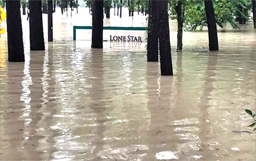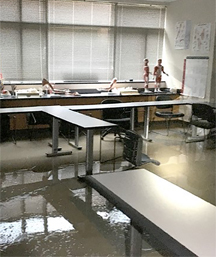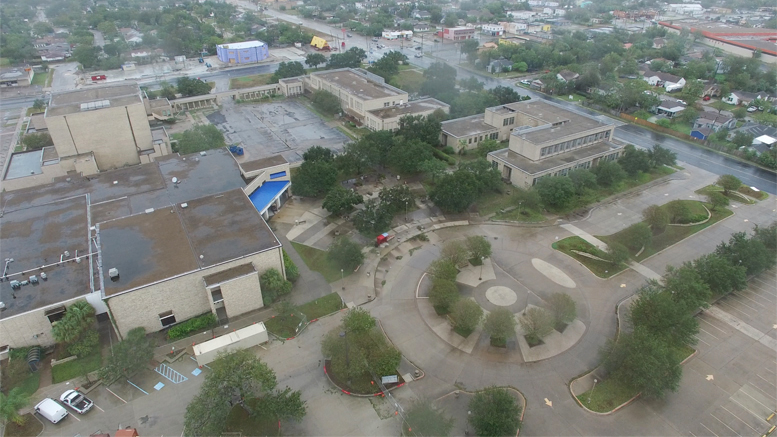Community colleges on Texas’ Gulf Coast are assessing damages after Hurricane Harvey decimated the region, reaching out to help affected students and employees and incorporating flexibility into their course schedules and deadlines.
Many thousands of people in the Houston area lost their homes and cars in the unprecedented flooding caused by the storm, and colleges still don’t know how many students won’t be coming back this semester.
Higher education leaders from Texas and around the country launched the Harvey HELP Fund, a crowd-sourced relief fund dedicated to aiding the close to 500,000 students affected by the hurricane. That effort is being led by several organizations, including the Texas Association of Community Colleges, Texas High Education Coordinating Board and Austin Community College.
The American Association of Community Colleges plans to share information about the needs of Gulf Coast colleges to its members.
“We are grateful for the outpouring of support and offers of assistance from AACC member colleges,” said AACC President and CEO Walter Bumphus.
Meanwhile, the Dallas County Community College District (DCCCD) encourages students who evacuated from the Gulf Coast to enroll in any of DCCCD’s seven colleges. As of August 29, two students had done so, said DCCCD spokesperson Ann Hatch.
Major damages
Lone Star College was especially hard-hit by Hurricane Harvey. Six of the nine buildings on the Kingwood campus suffered severe flooding damage – as much as four feet in some cases – when the San Jacinto River overflowed its banks, reported Chancellor Steve Head, who also serves on the AACC board of directors.
The entire electrical plant – housing generators and transformers – the data center, health professions building, and three or four classroom buildings were flooded, and sewer backups added to the misery.
Kingwood, which serves 11,000 students, will remain closed for six to eight weeks, Head said. Lone Star is working on leasing space at other buildings for Kingwood students, such as community centers, churches and medical facilities, and is moving as many classes as possible online.
The start of classes at other Lone Star campuses was delayed from August 28 to September 5. There was minor damage throughout the system, including wind damage at the CyFair campus caused mainly by high winds.
Head estimates facility repairs at Lone Star will cost $6 million to $8 million.
Three campuses – CyFair, North Harris and Tomball – hosted emergency shelters and served as staging areas for the National Guard.
Back to normal
“My goal is to get students back in school and get them back to normal as soon as they can,” Head said. “We went through this with Hurricane Ike (in 2008). It’s just a matter of getting organized, thinking things through and reaching out to students and employees.”
Many students and employees lost their homes and cars, he said, and because the devastation is so widespread, it’s difficult to find contractors to carry out repairs.

Flooding at Lone Star College-Kingwood caused by Hurricane Harvey. (Photo: LSC)
“We’re trying to be as flexible as we can with students and employees,” he said. Many courses that are normally six weeks are being restructured to six, eight, 10, 12 or 14 weeks so they can start later in the semester.
Lone Star also extended the deadline for tuition payments. Employees were given the option to stay home during the first week after Harvey without using vacation or personal days or bring their children to work, as some school districts hadn’t open yet. Employees, including part-timers, are being paid for the time they missed, and adjuncts are being paid even if their classes don’t start until later.
Lone Star has about $1 million in emergency aid for students and employees affected by Harvey, including $500,000 an individual donated anonymously to the Lone Star College Foundation, $200,000 from the chancellor’s discretionary fund and workforce funds from the state that can be used for disaster relief.
So far, about 500 students and 100 employees asked for assistance, Head said.
He estimates Lone Star, which serves about 87,000 students in credit programs, will take a hit in enrollment due to the storm, resulting in a $3 million loss in tuition revenue. Before Harvey, the college had predicted a 5 percent enrollment increase, but as of September 5, enrollment was up just 1 percent.
Lone Star had planned to open a facility this month to train people for jobs in the construction trades, Head noted. Now the college expects to expand those programs to meet the community’s needs for reconstruction.
Assessing the impact
Houston Community College is also considering expanding construction and welding programs as the city begins to rebuild.
HCC delayed the start of classes from September 5 to September 11 because even though the college experienced minimal impact, such as parking lot flooding, many students and staff suffered major losses.
“The magnitude is unprecedented,” said Linda Toyota, associate vice chancellor for communications.
An incident management team began meeting at HCC before the storm, and a recovery team has been working continuously throughout the crisis.
HCC is still assessing damages and the impact on dual-credit and continuing education programs that take place off site. The student services department is reaching out to determine whether students are in shelters and what assistance they need.
“The way people have come together has been inspiring,” Toyota said, noting that people have taken in strangers who lost their homes.
HCC is encouraging people to donate online to the Red Cross and the college’s foundation, which is supporting scholarships for students affected by Harvey.
Help for students
Buildings at San Jacinto College experienced minor roof leaks and fallen ceiling tiles, while a tunnel at the North Campus was flooded, said Amanda Fenwick, vice president of marketing and public relations.
“While college facilities sustained minor damage, we know that many San Jacinto College students and employees are facing hardships from the devastating effects of this storm,” said Chancellor Brenda Hellyer, a member of the AACC board. “We appreciate the support of our community in helping our students and employees through this difficult time.”
The college’s foundation started an emergency relief fund to assist students and employees and is working on a process for distributing the funds.
“This is so widespread,” Fenwick said. “We know students and faculty are affected. We’re trying to communicate with them. But if they’re in the middle of a crisis, they’re not going to answer their phone.”
The college is responding to students on Facebook who said they’ve lost their homes or cars but still want to figure out a way to stay in school.
The start of the fall semester at San Jacinto was delayed from August 28 to September 5. The registration deadline was extended to September 11. The college is working on a plan to revise the schedule so the academic calendar won’t need to be extended.
Deadlines extended
Del Mar College in Corpus Christi, which didn’t suffer major damages, delayed the start of the semester by one week and is changing its rules and deadlines because many students and employees live in areas hard-hit by Harvey.
Water seeped under the doors of some buildings, the basement of the main library was inundated with up to three feet of water, and there were power outages caused by compromised electrical panels, said Claudia Jackson, executive director of strategic communication and government relations.
“There were no catastrophic facility damages, it was mostly inconveniences,” Jackson said, although the growth of mold and mildew could become a health hazard.

A classroom full of water at Lone Star College-Kingwood. (Photo: LSC)
A campus building funded by Federal Emergency Management Agency (FEMA) for training first responders was taken over by FEMA during Harvey and the recovery efforts.
The deadlines for registration, scholarships and emergency loans were extended, Jackson said, and if students had already received scholarships, the amounts were increased to the maximum allowed.
About 500 students were in the process of paying tuition when the storm hit, she said. The college is reaching out to them to see if they will be able to come back to school and to let them know they can get a full refund and won’t be charged a fee for changing their schedule or stopping out for the semester.
“We will be as lenient as we can,” Jackson said.
Del Mar is adding new eight-, 14- and 15-week classes to accommodate students who won’t be able to attend standard 16-week classes.
“If we can provide flexibility to our students and employees, we’re going to make that happen,” she said.
Community reaches out
At least two Del Mar employees have lost their homes, Jackson said, and the college is connecting them with local services. It also set up a program through its foundation to connect donors with people who can help. One staff member asked to borrow a chain saw to remove a fallen tree from a front porch, for example, while other employees offered to put up homeless colleagues in a spare bedroom.
When the storm hit Corpus Christi, it was already downgraded, and while heavy rains were forecast, “it wasn’t a huge concern,” Jackson says. Then a few hours later, the president urged everyone to leave campus. “It literally went from ‘We can weather the storm with good rain gear’ to ‘We’ve all got to get out of here.’’”
“Some of the communities we serve are fishing villages right on the water. Those areas were devastated,” Jackson said. “It’s really eerie. There are houses where it looks like there is no damage, and the house next door has nothing left but the foundation.”
Jackson singles out two Del Mar employees for going above and beyond during the crisis. Even though his own house was heavily damaged, master electrician Robert Shannon spent two nights on campus pumping water out of buildings and restoring electricity.
Charles Miller, superintendent of buildings and grounds, was just two days from retirement when the storm hit. After taking his family to Dallas, he returned to the college and plans to stay until cleanup and repairs are complete.
“My campus needs me,” he said.

